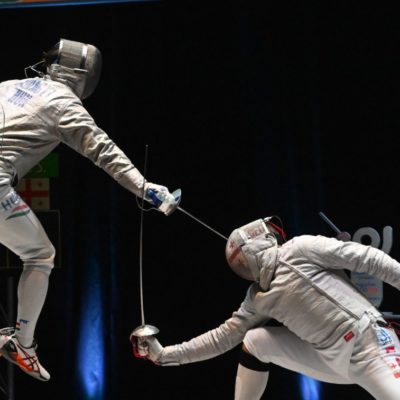This article is another translation provided to us by Giogio Bassa and the great site SchermaSport. Most fencers in the US and Canada learned under a system that derived from French fencing roots. This article goes into how the Italian school teaches counter-offensive actions.
Counter Offensive Actions in Italian Treatises
Foil was born in France in the XVIII century as a weapon to be used in a salle. In duels the “arma da terreno” i.e., today’s épée was used. To train and learn the art of fencing in a salle a modified épée was introduced, namely the foil which was lighter, with a smaller blade’s cross section and therefore more flexible, with a leather button covering the tip resembling the bud of a small flower (fleuret in French, fioretto in Italian).
The convention was introduced and the rules of ROW established to make the training session more effective and to get everybody used to the concept that in a duel it was better if only one of the duelists would die!
“Uscite in tempo” (exits in tempo) is an Italian synonym for counterattacks. If one wants to be more precise with the Italian terminology it could be translated as “counterattacks with a choice in tempo” but this may be redundant since the term counterattack already implies the meaning of executing an action by catching/synchronizing with the rhythm of the opponent and hence robbing him of one or more fencing tempos.
There are differences between the three weapons in regards to “uscite in tempo” (counterattacks) because of the rules governing each weapon.
In épée it makes little sense to categorize the counterattacks as for foil and saber.
At least according to the Italian tradition, unless one uses the same terminology in épée as in foil, it makes no sense to classify different “uscite in tempo” (counterattacks). The reason is because of the double touch (one point for each fencer) which changes the concept of “uscite in tempo” (counterattacks). In épée, any action while attacking can become “uscita in tempo” (counterattack) if the attack arrives within a timing suitable to overcome the limit of the blocking time of the apparatus (1/20-25th of a second). While in foil the fencing tempo is in essence a concept, in épée, given the short lock out interval between the two light, it is a real physical and measurable time interval.
We shall now examine the “uscite in tempo” counterattacks in the Italian fencing treatises for foil and saber.
1. Note on translation from Italian into EnglishThere are words which are used in the general language and in the fencing lingo with different meaning. In this case we try to explain in the text the difference between the two.Example:fingere, v., (Ita.) or fare finta = to feign, v.finta, n., (Ita.) = feint, n.In English fencing lingo “feint” describes a specific compound action.Therefore, to explain that someone “fa una finta” = makes a feint, feigns something, for clarity’s sake we render in English as “hints at something” but then does not commit to the action, in other words he tries to trick the opponent with his “finta” (feint).
2. Note on fencing positions
Please refer to the lesson of “Fencing Terminology in the Italian School and the French School, i.e., the Rest of the World” https://fencing.net/content/view/455/35/
3. Note about the term ‘cavazione’
The term “cavazione” in Italian refers to any action to disengage, to free oneself from the opponent’s blade, be it to avoid a parry (when you are attacking), or a search of the blade, or also to free the blade which was subject to the opponent’s engagement.
The French, i.e., the rest of the world, are more precise in their terminology:
“trompement” is “cavazione” to avoid the parry;
“derobement” is “cavazione” to avoid the searching of the blade by the opponent;
“désengagement” is “cavazione” to free oneself from the opponent’s engagement.
The “cavazione in tempo” which is part of the counterattacks is called “derobement” because it is used to prevent the opponent to gain ROW by touching our blade already in line.
In the modern version, the blade of the fencer who executes a “cavazione” may not be in line, but what is important is that, against the opponent’s blade which is advancing trying to touch our blade, one should avoid the contact between the blades and then hit the opponent.
A. Foil Counterattacks in Italian Fencing Treatises
Counterattack is the fencing action executed against the attack by the adversary without parrying his attack first, but avoiding his attack or interrupting the execution of his attack with one hit. The fencer executing the counterattack, for it to be valid, must not be touched himself during the action, except in the case of the counterattack of “cavazione in tempo” (derobement).
Figure indicates the targets used in the description of the counterattacks
The tradition of the Italian treatises about foil considers seven types of counterattacks
1. Cavazione in tempo (Derobement): this is a counterattack to get away from the opponent’s blade followed by a straight thrust with a lunge. In the tradition of the duel this touch was not considered a valid one unless the “cavazione in tempo” (derobement) was executed with a lunge. This is the only counterattack which is always valid even when he who executes the movement is hit in turn by the conclusion of the opponent’s attack.
Fencer A: executes an “attacco di battuta e botta dritta” (beat attack)
Fencer B: avoids the beat attack by A with a “cavazione” (derobement), lunges, and hits.
2. Arresto (Stop-Hit): this is a counterattack which to be valid must anticipate the last tempo of the opponent’s action by one ore more fencing tempos, AND close the line (stop) on which the attack would have been concluded.
- If the final movement of the attack is directed to the high or to the outside line, the stop must be directed to the chest.
- If the final movement of the attack is directed to the flank or to the inside line, the stop must be directed to the flank.
Fencer A: is in tierce or sixte position
Fencer B: executes a compound attack of “finta” (feint) to the inside line and “cavazione” (trompement) towards the outside line to avoid (English treatises usually say ‘to deceive’) the parry of quarte or quinte by Fencer A
Fencer A: just ‘hints’ to a parry quarte or quinte on B’s feint (first movement) and immediately executes a straight thrust (the stop) to the chest exactly at the same time when B is transitioning from his “finta” (feint) to the” cavazione” (derobement).
3. Contrazione (Stop-Hit with Opposition): a counterattack which can be executed on the last tempo of any attack action by the opponent, with the suitable “opposizione di pugno” (opposition with the fist), i.e., his bell guard which opposes the opponent’s blade is pushed by his fist do deflect the tip away from the intended target. This is executed preferably without the lunge.
Fencer A: is in tierce or sixte position.
Fencer B: executes a composite attack of a “finta” (feint) to the inside line and “cavazione” (trompement) towards the outside line to avoid (”to deceive” as the English treatises say) the parry quarte or quinte by Fencer A.
Fencer A: parries quarte on B’s feint (first movement) and on the second movement (the lunge) throws a straight hit to the chest with a strong opposition in the line of tierce, by pushing away B’s blade and hitting him at the same time.
4. Inquartata (unknown English equivalent term): a counterattack which can be executed against the attacks to the chest on the inside, i.e., starting from your own position of tierce or sixte. By sliding the back foot sideways to the right on the outside, one assumes a position in profile by removing/reducing the target to the hit by the opponent, and at the same time with “opposizione di pugno” opposition with the bell guard (see above) on the inside high line, he can hit at the attacker’s inside line.
Fencer A: (righthanded) is in tierce or sixte position
Fencer B: executes an “attacco di battuta e botta” (beat attack) to the inside line
Fencer A: shifts his body sideways to his right to avoid the hit and at the same time he extends his arm with opposition in the line of quarte thrusting his hit to the chest.
Or
Fencer A: (lefthanded) is in tierce or sixte position
Fencer B: executes an “attacco di battuta e botta” (beat attack) to the inside line
Fencer A: shifts his body sideways to his left to avoid the hit and at the same time he extends his arm with opposition in the line of quarte thrusting his hit to the flank.
5. Passata sotto (no English term): a counterattack which can be executed against attacks to the outside line or to the upper chest. One extends the weapon arm, and at the same time executes a reverse lunge, i.e., extending backwards the back leg and flexing his body at the pelvis to lower the trunk. In the modern version of this action one neither rests the left hand on the strip, nor executes it with a reverse/backwards lunge (so called because the back leg moves backwards and the front leg stays in place), but instead with feet together squatting down.
Fencer A: (righthanded) is in quarte or quinte position, or in seconde or octave position
Fencer B: executes an “attacco di battuta” (beat attack) to the outside or upper chest line
Fencer A: avoids the hit by lowering his body and at the same time hitting his opponent’s flank.
There are two more types of counterattack described in the Italian treatises, even though they are much less frequent and rarely applicable in modern foil.
6. Appuntata (no English term): this is a counterattack on the compound riposte by the opponent. The counterattack is directed with “opposizione di pugno” opposition with the bell guard (see above) against the same target on the opponent which he had chosen to hit on us, and is executed by lifting the forward foot to fall immediately in a lunge at the same time the opponent transitions from his parry to the “cavazione” (trompement).
Fencer A: “attacco diretto” (direct attack) to the inside line
Fencer B: parries in quarte or quinte and ripostes with a feint to the inside line and “cavazione” (trompement) to avoid the counterparry usually of quarte or quinte.
Fencer A: only ‘hints’ the counterparry of quarte or quinte, and thrusts a second hit to the chest, closing the line of attack by his opponent at the exact moment when B is transitioning from the “finta” (feint) to the “cavazione” (derobement)
7. Imbroccata (no English term): a counter-attack on the “azioni di filo” (“filo” corresponds approximately to the English ‘glide’) and “fianconata” (corresponds to English ‘bind’ or French ‘liement’) which end on the flank. “Imbroccata” is a hit directed to the flank, keeping the on guard position with the fist in seconde or quarte, opposition in the line of seconde, on the movement of the “filo” (glide/slide) by the opponent, without lunging.
Fencer A: executes the “attacco di fianconata” (bind, liement)
Fencer B: on the second movement of the attacker A taking the blade (prise de fer) in seconde or octave, B extends his arm directing the hit to A’s flank.
B. Saber Counterattacks in Italian Fencing Treatises
According to the Italian treatises there are six different types of counter-attack in saber
- Tempo al braccio (Stop-cut Parry and Riposte): this counterattack can be executed in the first, second or even last tempo of an opponent’s compound attack action. It is more difficult to execute without being touched if the opponent attacks in a single tempo, i.e., in a single movement. The "tempo al braccio" or "tempo" is executed by retreating, and is followed by a parry going back one step and coordinating the hit with the movement of the back foot and the movement of the blade to parry, while pulling back the front foot.
Fencer A: attacks with a compounded attack head-flank-head
Fencer B: on A’s first movement throws the hit under the weapon arm of A and goes immediately in a parry quinte position while retreating
Or
on A’s second movement throws the stop-cut over the weapon arm of A and goes immediately in a parry tierce position while retreating
Or
on A’s third and final movement throws the stop-cut under the weapon arm of A and goes immediately in a parry quinte position while retreating.
2. Arresto di puntata (Stop-hit with the Point): this is called stop hit with “puntata” in Italian, or stop-hit with the point. The counterattack consists in anticipating by one tempo the action of the compound attack of the opponent, by closing his transition from the initial line of attack to the final one. The stop hit is executed against the flank when the feint of the opponent’s attack is directed either to the outside line or to the high line, to then conclude the attack at the inside line or to the flank. Conversely, a stop hit with the point to the chest is executed when the feint of the attack is either directed to the flank-head, or when it is aimed to the inside line to then shift to the outside line.
Fencer A: is in quinte position
Fencer B: executes a compound attack flank-head to evade the parry seconde of A
Fencer A: only hints to (feigns) the parry seconde and throws the stop hit with the point to the chest.
3. Cavazione in tempo (Derobement): a movement to disengage from the opponent’s blade, followed by a straight thrust with lunge. This is the only counterattack which is always right even when he who executes it is hit by the conclusion of the opponent’s attack.
Fencer A: is in position with the arm stretched in line
Fencer B: executes a beat attack
Fencer A: avoids the beat by B with a “cavazione” (derobement) and lunges
4. Inquartata (no equivalent English term): a counterattack thrown to the left cheek of the opponent when he tries to hit either the head or the left cheek with a cut, or the chest with the point.
Fencer A: is in quinte position
Fencer B: executes a compound attack flank-head
Fencer A: shifts his body to his right to avoid the hit and at the same time extends his arm with opposition in the line of quarte by throwing a cut to the left cheek of B.
These next two counterattacks are less frequently used in modern saber fencing but they are discussed in the Italian treatises.
5. Appuntata (no equivalent English term): counterattack with the point on the compound riposte by the opponent, directed with “opposizione di pugno” opposition with the bell guard (see above) to the same target onto which the attack was aimed at, i.e. the corresponding target on the opponent to what he wanted to hit on us, and executed by lifting a bit the front foot to fall into the lunge immediately and at the same moment when the opponent is transitioning from the parry to the “cavazione” (trompement).
Fencer A: direct attack to the flank
Fencer B: parries in seconde and does a compound riposte head-flank to avoid the counterparry usually of quinte by A
Fencer A: feigns a counterparry of quinte and throws a second hit to the flank, closing the line of attack of the opponent
6. Contrazione (Stop-hit with Opposition): counterattack by hitting with the point against the last tempo of any cut by the opponent directed either to the chest or to the flank. This is executed with a strong “opposizione di pugno” opposition with the bell guard by thrusting the hit with the point to either the flank or the chest.
Fencer A: is in quarte position
Fencer B: throws a compound attack chest-chest
Fencer A: on the second and last movement by A, throws the hit with the point to the chest with “opposizione di pugno”opposition with the bell guard in a direction opposite to the position of B.
~~~~~~~~~~~~~~~~~~~~





